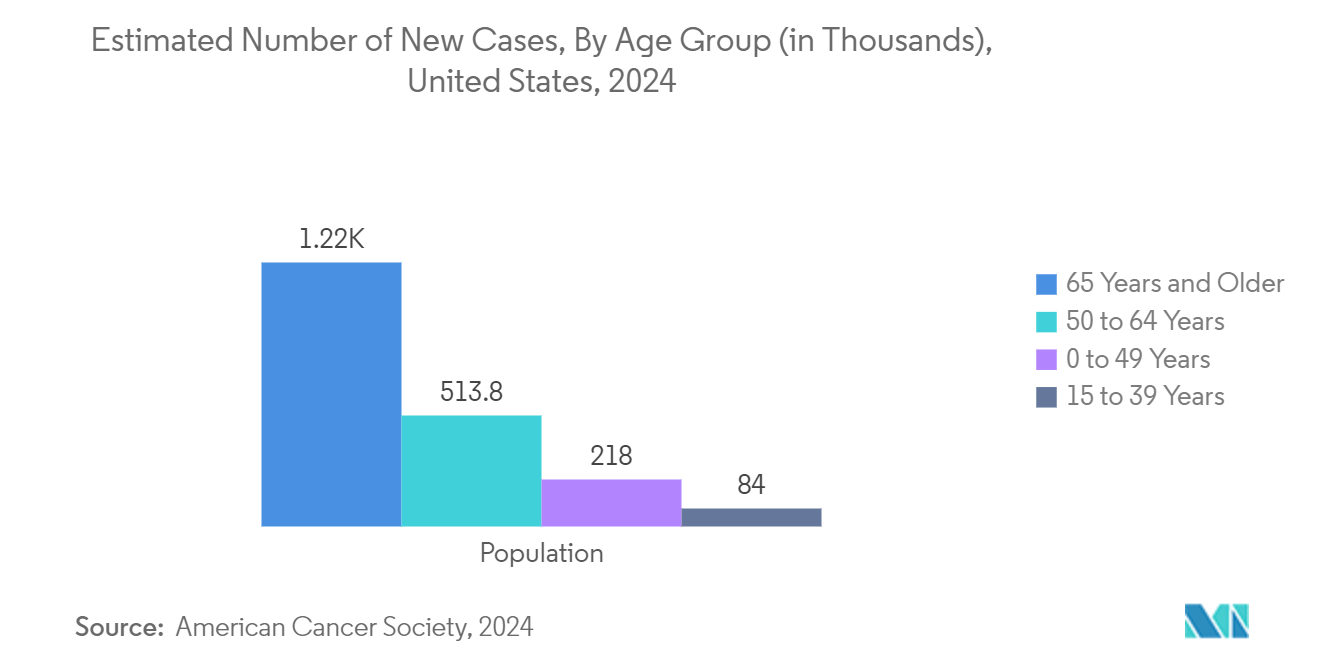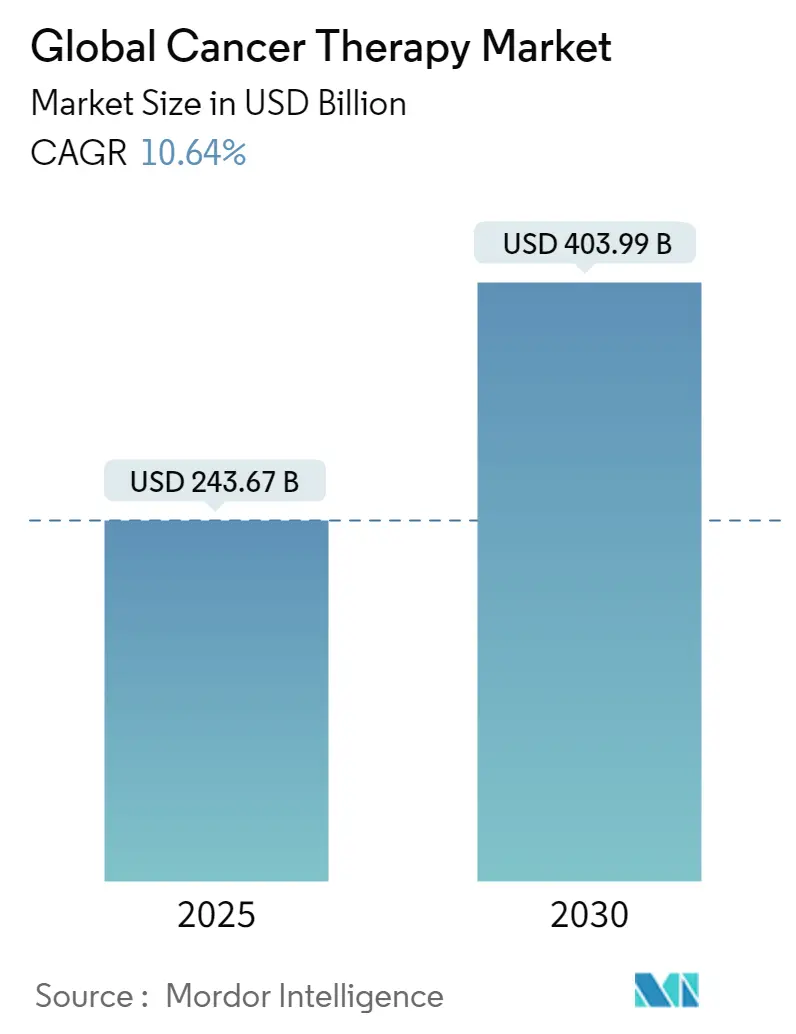
| Study Period | 2021 - 2030 |
| Market Size (2025) | USD 243.67 Billion |
| Market Size (2030) | USD 403.99 Billion |
| CAGR (2025 - 2030) | 10.64 % |
| Fastest Growing Market | Asia Pacific |
| Largest Market | North America |
| Market Concentration | High |
Major Players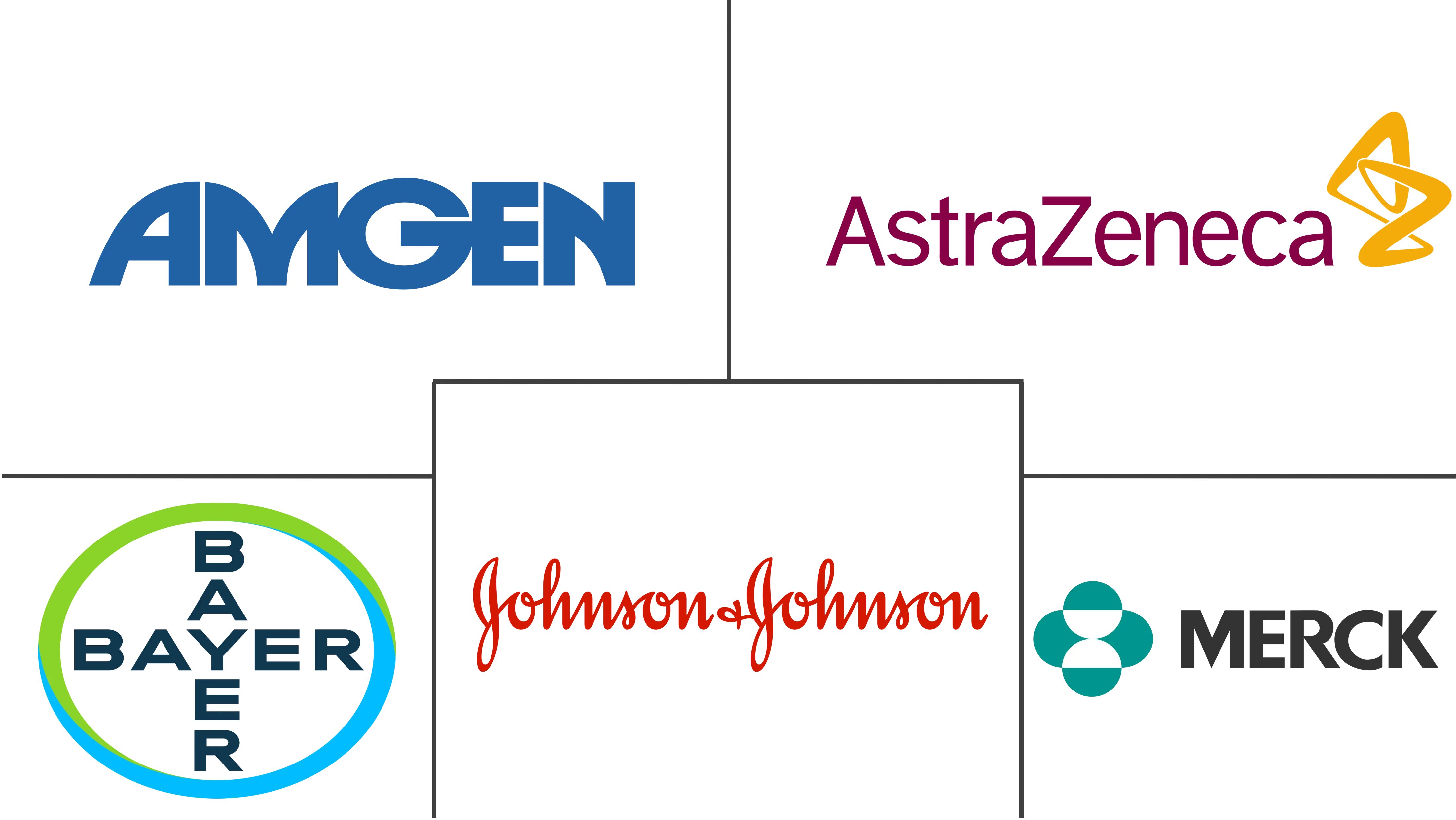
*Disclaimer: Major Players sorted in no particular order |
Cancer Therapy Market Analysis
The Global Cancer Therapy Market size is estimated at USD 243.67 billion in 2025, and is expected to reach USD 403.99 billion by 2030, at a CAGR of 10.64% during the forecast period (2025-2030).
The factors driving the growth of the Cancer Market include increasing patient assistance programs (PAPs), increasing government initiatives for cancer awareness, the rising prevalence of cancer worldwide, vital R&D initiatives from key players, and the increasing demand for personalized medicine. For instance, in November 2023, the American Cancer Society introduced a new program, Community Access to Resources, Education, and Support (ACS CARES), which provides quality information and one-on-one support to cancer patients through a mobile application. This program focuses on improving the accessibility of cancer care services to patients and caregivers by improving information. Thus, such initiatives may enhance the adoption of Cancer Therapy and contribute to the growth of the Cancer Therapy Market.
The technological advancements to enhance the planning of personalized medicines fuel the demand and raise its adoption; thus, it is expected to contribute to the market's growth. Artificial intelligence-based technology for Precision Oncology improves healthcare professionals in therapy planning and early multi-cancer diagnostics. It is used in applications such as developing personalized medical products by utilizing patient data to improve the effectiveness and safety of therapy for cancer patients, fueling the demand for Personalized Cancer Treatment.
Furthermore, the growing burden of cancer globally further raises the need for cancer therapies to treat different types of cancers and is anticipated to drive the growth of the Global Cancer Market. For instance, in January 2024, according to the American Cancer Society, over 18 million Americans were reported to have a history of cancer in the year 2022. It is estimated that over 2 million new cancer cases are expected to be diagnosed in the United States in 2024.
Thus, the factors above, such as the rising burden of cancer, the increasing number of government initiatives, and increasing demands for personalized medicine, contribute to the growth of the Cancer Treatment Market during the forecast period. However, the fluctuations in reimbursement policies and the high cost of cancer therapies can impede the market's growth.
Cancer Therapy Market Trends
The Targeted Therapy Segment is Expected to Witness Significant Growth during the the Forecast Period
The drugs that work by targeting the proteins or specific genes in the cancer cells are known as Targeted Therapy. Researchers are exploring a wide range of novel targets in the quickly expanding field of targeted therapy in cancer research, contributing to the growth of the Targeted Therapy Market.
The introduction of patient assistance programs supports the accessibility and growth of the Targeted Therapy Market segment. For instance, in July 2023, the Ministry of Health in Vietnam launched a patient assistance program to improve the affordability of targeted therapy Brentuximab vedotin drug and improve patients' quality of life with malignant lymphoma. Additionally, the same resource reported that malignant lymphoma is increasingly rising and is considered in the list of 35 most common cancers in Vietnam. Thus, the affordability of the drug enhances its adoption for the treatment of malignant lymphoma and fuels the segment's growth.
Moreover, the growing burden of cancer cases such as lymphoma fuels the need for Targeted Therapy for its treatment as this therapy effectively targets tumors; thus, it's anticipated to contribute to the growth of the Targeted Cancer Therapies Market. For instance, according to the American Cancer Society, around 89,100 new lymphoma cases are expected to be diagnosed in 2024 in the United States. Thus, the high prevalence of cancer cases fuels the need for targeted therapy and drives market growth.
The market players' key developments in Targeted Therapy have also boosted the segment's growth. For instance, in August 2023, Eli Lilly and Company introduced the positive outcomes from the LIBRETTO-431 study, in which the targeted therapy Retevmo (selpercatinib) represented an improvement in progression-free survival (PFS) in comparison to the PD-1 inhibitor plus Chemotherapy for patients who have advanced or metastatic non-small cell lung cancer (NSCLC).
In December 2022, Ferring Pharmaceuticals got approval from the United States Food and Drug Administration (US FDA) for its adenovirus vector-based Gene Therapy, Adstiladrin (nadofaragene firadenovec-vncg). The targeted gene therapy vector is intended for the treatment of Bacillus Calmette-Guérin (BCG)-unresponsive non-muscle invasive bladder cancer (NMIBC) with carcinoma in situ (CIS) with or without papillary tumors of high-risk adult patients.
Thus, given the increasing product approvals and growing research activities for targeted cancer therapy development, the studied segment is anticipated to grow during the forecast period.
North America Currently is Expected to Witness Significant Growth during the the Forecast Period
North America is expected to increase its market share during the forecast period, owing to the increased adoption of Cancer Therapy and the high burden of cancers in the United States. For instance, according to the data published by the Canadian Cancer Society in November 2023, an estimated 239,100 individuals in Canada were diagnosed with cancer in 2023, and around 45% of individuals are expected to be diagnosed with cancer during their lifetime.
Furthermore, the high concentration of key players in North America, with strategic initiatives such as product approvals and increased investment in research and development activities, is anticipated to stimulate the Cancer Treatment Market in the region. For instance, in January 2023, Kite, the subsidiary of the Gilead Company, and Arcellx, Inc. signed a global strategic alliance to co-develop and co-commercialize CART-ddBCMA, Arcellx's lead late-stage product candidate. The Cancer Therapy is intended for treating patients with relapsed or refractory multiple myeloma. Similarly, in November 2022, AstraZeneca received USFDA approval for its Imjudo (tremelimumab) plus platinum-based Chemotherapy for treating Stage IV (metastatic) non-small cell lung cancer (NSCLC) in adult patients.
Thus, given the factors above, such as the increasing burden of cancer and strategic initiatives taken by the market players, the Cancer Therapy Market in North America is expected to grow significantly over the forecast period.
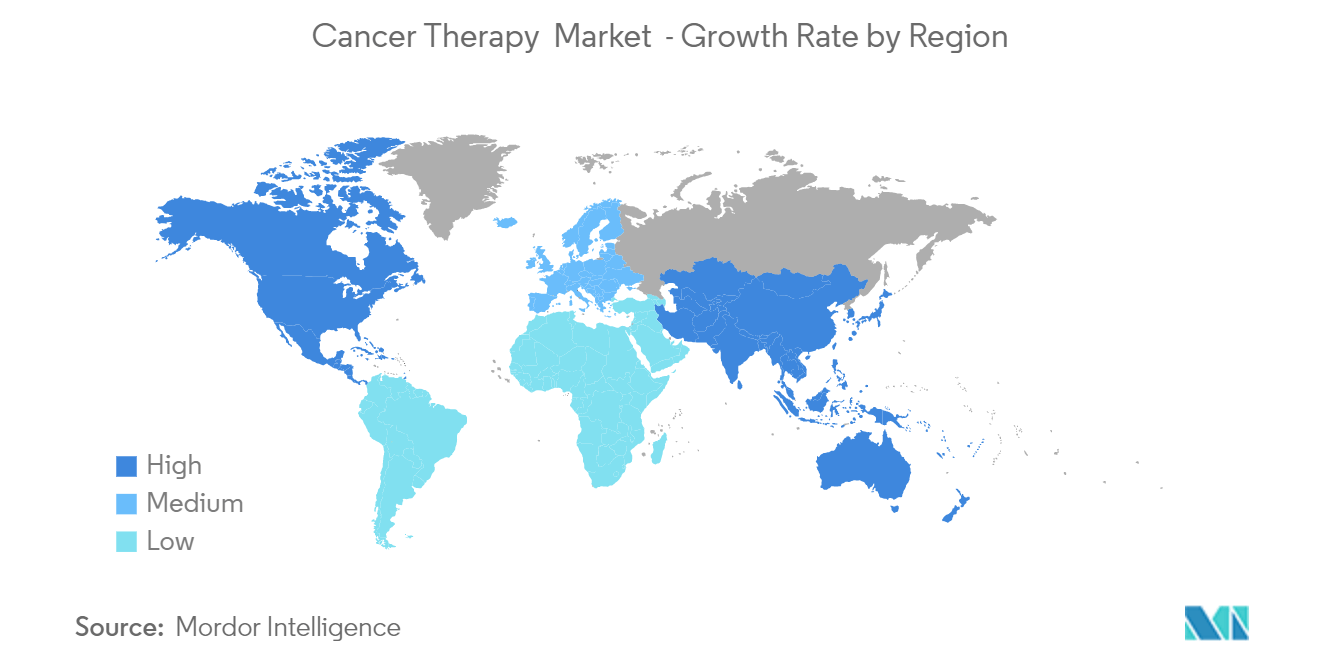
Cancer Therapy Industry Overview
The Cancer Therapy Market consists of several major players and is highly competitive. In terms of market share, a few of the major players currently dominate the market. Various strategies are adopted by the market players, such as collaborations and acquisitions for product portfolio development and to expand their capabilities. The players, namely Amgen Inc., AstraZeneca, Bayer AG, Bristol-Myers Squibb Company, Pfizer Inc., Novartis AG, and Johnson & Johnson Services, hold significant shares in the Global Oncology Market.
Cancer Therapy Market Leaders
-
Amgen Inc.
-
AstraZeneca PLC
-
Bayer AG
-
Johnson and Johnson
-
Merck & Co. Inc.
- *Disclaimer: Major Players sorted in no particular order
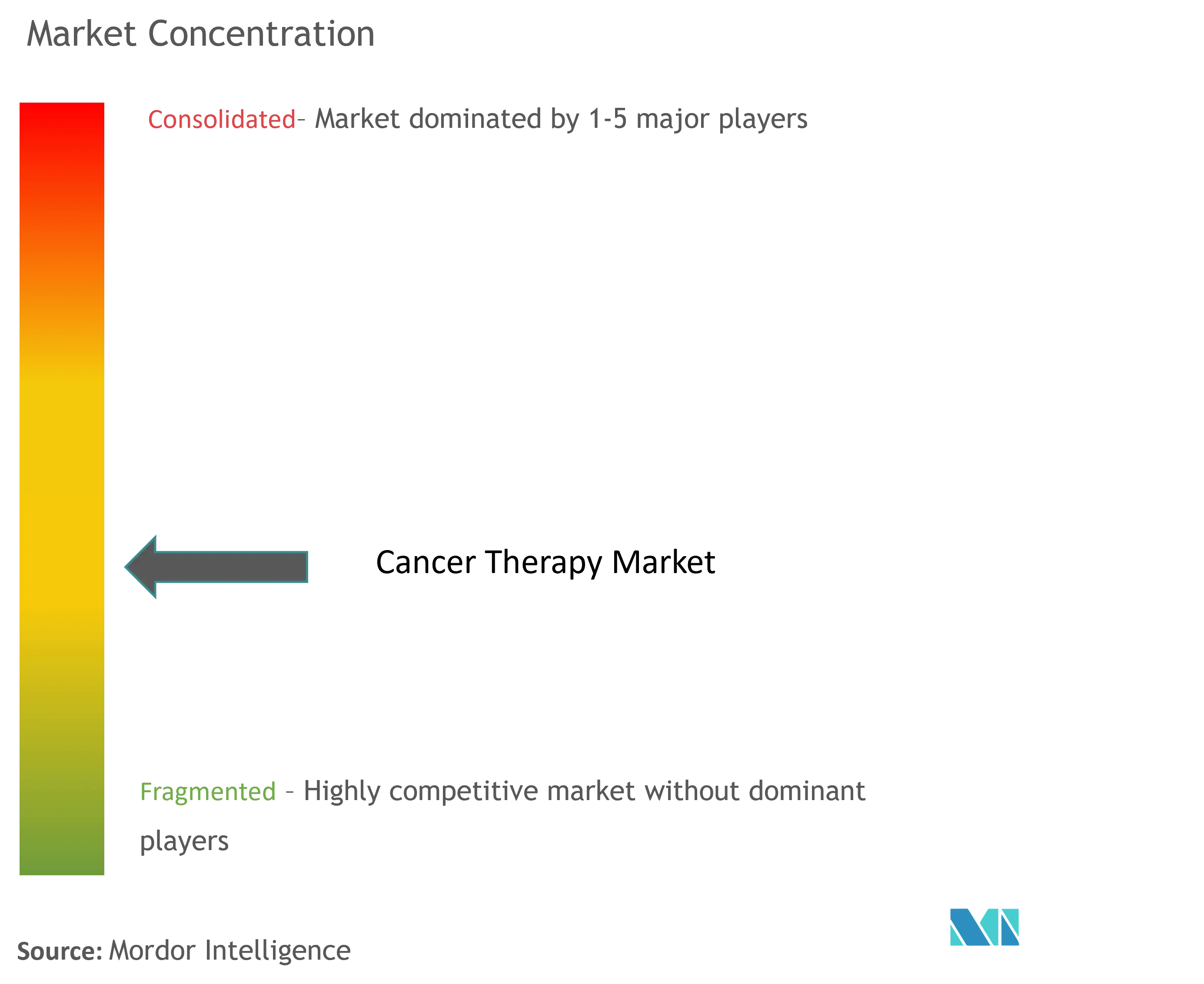
Cancer Therapy Market News
- In May 2023, Genmab A/S received USFDA approval for its T-cell engaging bispecific antibody, EPKINLY (epcoritamab-bysp), which was intended for the treatment of relapsed or refractory (R/R) diffuse large B-cell lymphoma (DLBCL) in adult patients.
- In April 2023, Genentech, a member of the Roche Group, received USFDA approval for its cancer therapy drug, Polivy (polatuzumab vedotin-piiq) in combination with Rituxan (rituximab), cyclophosphamide, doxorubicin and prednisone (R-CHP). The drug is intended for the treatment of previously untreated diffuse large B-cell lymphoma (DLBCL) in adult patients.
- In April 2023, Gamida Cell Ltd received USFDA approval for its allogeneic cell therapy, Omisirge (omidubicel-onlv), intended for adult and pediatric patients 12 years and older with hematologic malignancies.
Cancer Therapy Industry Segmentation
According to the scope of the report, cancer therapies are drugs that obstruct the growth and augmentation of cancer by interfering with specific molecules, such as DNA or proteins, that are involved in the development or expansion of cancerous cells. These therapies incorporate surgery, chemotherapy, radiation therapy, immunotherapy, and others. The market is segmented by therapy type, cancer type, end user, and geography. The market is segmented by therapy type into immunotherapy, chemotherapy, targeted therapy, hormonal therapy, and other therapy types. By cancer type, the market is segmented into breast cancer, blood cancer, gastrointestinal cancer, prostate cancer, respiratory/lung cancer, gynecologic cancer, and other cancer types. By end user, the market is segmented as specialty clinics, hospitals, and cancer and radiation therapy centers. The market is geographically segmented into North America, Europe, Asia-Pacific, South America, the Middle East and Africa. The market size is provided for each segment in terms of USD value.
| By Therapy Type | Chemotherapy | ||
| Targeted Therapy | |||
| Immunotherapy | |||
| Hormonal Therapy | |||
| Other Treatment Types | |||
| By Cancer Type | Blood Cancer | ||
| Breast Cancer | |||
| Prostate Cancer | |||
| Gastrointestinal Cancer | |||
| Gynaecologic Cancer | |||
| Respiratory/Lung Cancer | |||
| Other Cancer Types | |||
| By End User | Hospitals | ||
| Specialty Clinics | |||
| Cancer and Radiation Therapy Centers | |||
| Geography | North America | United States | |
| Canada | |||
| Mexico | |||
| Europe | Germany | ||
| United Kingdom | |||
| France | |||
| Italy | |||
| Spain | |||
| Rest of Europe | |||
| Asia-Pacific | China | ||
| Japan | |||
| India | |||
| Australia | |||
| South Korea | |||
| Rest of Asia-Pacific | |||
| Middle East and Africa | GCC | ||
| South Africa | |||
| Rest of Middle East and Africa | |||
| South America | Brazil | ||
| Argentina | |||
| Rest of South America | |||
Cancer Therapy Market Research FAQs
How big is the Global Cancer Therapy Market?
The Global Cancer Therapy Market size is expected to reach USD 243.67 billion in 2025 and grow at a CAGR of 10.64% to reach USD 403.99 billion by 2030.
What is the current Global Cancer Therapy Market size?
In 2025, the Global Cancer Therapy Market size is expected to reach USD 243.67 billion.
Who are the key players in Global Cancer Therapy Market?
Amgen Inc., AstraZeneca PLC, Bayer AG, Johnson and Johnson and Merck & Co. Inc. are the major companies operating in the Global Cancer Therapy Market.
Which is the fastest growing region in Global Cancer Therapy Market?
Asia Pacific is estimated to grow at the highest CAGR over the forecast period (2025-2030).
Which region has the biggest share in Global Cancer Therapy Market?
In 2025, the North America accounts for the largest market share in Global Cancer Therapy Market.
What years does this Global Cancer Therapy Market cover, and what was the market size in 2024?
In 2024, the Global Cancer Therapy Market size was estimated at USD 217.74 billion. The report covers the Global Cancer Therapy Market historical market size for years: 2021, 2022, 2023 and 2024. The report also forecasts the Global Cancer Therapy Market size for years: 2025, 2026, 2027, 2028, 2029 and 2030.
Our Best Selling Reports
Cancer Therapeutics Industry Report
The report covers global cancer therapy market insights and is segmented by therapy type, cancer type, end user, and geography. This comprehensive industry profile provides an in-depth market analysis, including market size, market share, market trends, and market statistics. The industry report also includes a detailed market forecast and market outlook, offering valuable industry information and industry research on growth rate and market growth.
The cancer therapeutics market is analyzed by therapy types such as chemotherapy, targeted therapy, immunotherapy, hormonal therapy, and other therapy types. The report also segments the market by cancer types including blood cancer, breast cancer, prostate cancer, gastrointestinal cancer, gynecologic cancer, respiratory/lung cancer, and other cancer types. End users in the market include hospitals, specialty clinics, and cancer and radiation therapy centers.
Geographically, the market is segmented into North America, Europe, Asia-Pacific, Middle East and Africa, and South America. The industry analysis includes a historical overview and a market forecast outlook to provide a comprehensive understanding of the market dynamics. The report also highlights the market leaders and provides an industry overview, market review, and market predictions for the cancer therapeutics market.
This industry report is an essential resource for research companies and provides a report example in a free report PDF download. It includes industry reports, industry sales, industry size, industry statistics, industry trends, market data, market segmentation, market value, and a detailed market overview. The report is designed to provide valuable insights for stakeholders looking to understand the market landscape and make informed decisions.



